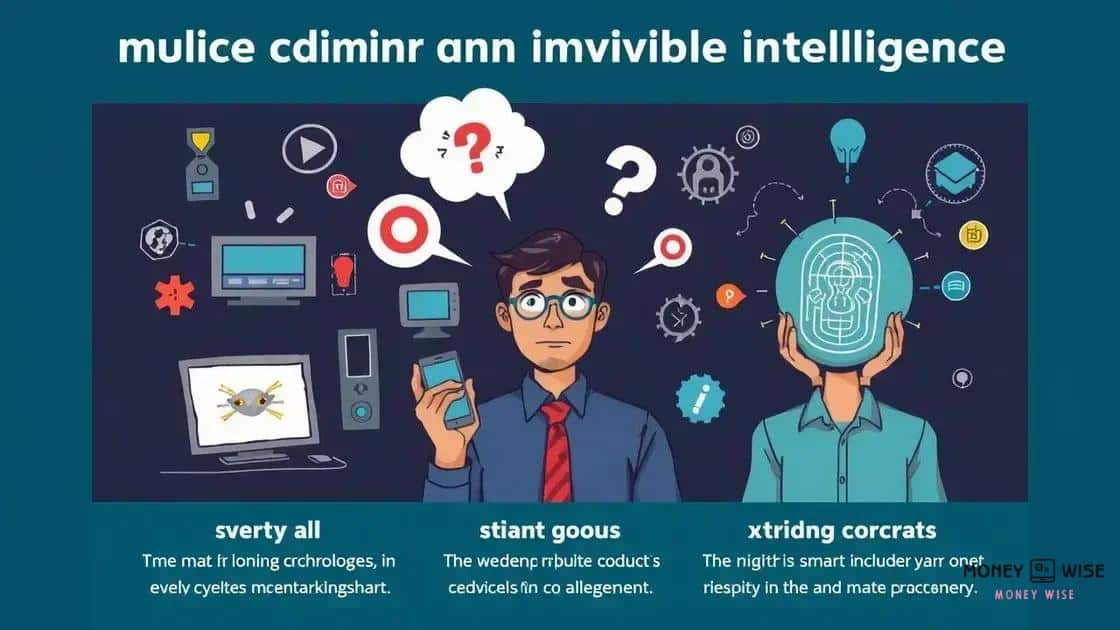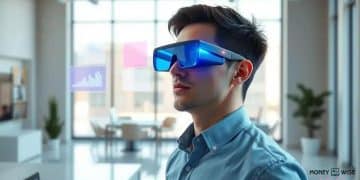Ambient invisible intelligence trends reshape our future

Ambient invisible intelligence refers to technology that adapts to user needs by creating smart environments that seamlessly enhance daily life and work through automation, personalization, and intuitive interactions.
Ambient invisible intelligence trends are making waves in the tech world, subtly influencing how we live and work. Ever wondered how these trends might reshape your day-to-day interactions with technology? Let’s dive in!
Understanding ambient invisible intelligence
Understanding ambient invisible intelligence is essential in today’s tech-driven world. This concept focuses on how technology interacts with us without becoming invasive. It reflects a shift towards seamless integration, making our interactions with devices more natural and intuitive.
The essence of ambient intelligence
At its core, ambient intelligence involves creating smart environments that respond to our presence and actions. This technology is often invisible, working in the background to enhance our experiences. Imagine a home that adjusts the lighting and temperature based on your mood without you having to lift a finger.
Key characteristics include:
- Context awareness: Devices understand and adapt to the user’s environment.
- Personalization: Technology tailors its responses to individual preferences.
- Seamless interaction: Communication occurs effortlessly, often without direct commands.
- Learning capabilities: Systems improve over time by analyzing user behavior.
Such characteristics illustrate how ambient invisible intelligence can enrich our lives. By anticipating our needs, these technologies can create healthier, more comfortable spaces. For instance, smart homes can learn when to turn on lights based on your daily routine, making life simpler and more enjoyable.
Examples in everyday life
Many common objects now incorporate these principles. Smart thermostats adjust temperatures based on your habits. Wearable fitness trackers monitor your health metrics without any active input. Even voice assistants learn the rhythm of your life to better serve you with timely reminders and information.
As we adopt more ambient invisible intelligence tools, it’s crucial to consider privacy and security. With great power comes great responsibility, and we must ensure that these systems are designed to protect our data while enhancing our quality of life.
Key trends driving the technology

The key trends driving the technology of ambient invisible intelligence are exciting and transformative. As technology evolves, these trends shape how we interact with our environments and devices. Understanding these trends helps us see the future of our daily lives.
Rise of smart homes
One major trend is the rise of smart homes. These homes incorporate various devices that can communicate with each other. For example, smart lighting systems adjust based on your activity. They can dim when you’re watching a movie or turn on automatically when you enter a room. This seamless integration enhances convenience and comfort.
Increased focus on privacy
Alongside this rise in smart technology, there is an increasing focus on privacy and security. As we adopt more ambient invisible intelligence, users want assurance that their data is safe. Companies are developing stricter guidelines and technologies to protect user information. This focus will likely lead to greater trust in these technologies.
Integration with artificial intelligence
Another key trend is the integration with artificial intelligence (AI). AI allows devices to learn from user behavior, making them more responsive and intuitive. For instance, a personal assistant might suggest actions based on your past interactions. This capability makes technology not just smart, but also personalized, transforming how we experience daily tasks.
Growth of wearable technology
Wearable technology is also on the rise. Devices such as fitness trackers and smartwatches monitor health metrics in real-time without requiring constant attention. Users can track their health effortlessly, fostering a proactive approach to wellness. This trend promotes a better understanding of individual health needs through technology.
The amalgamation of these trends paints a clear picture of the future. As ambient invisible intelligence continues to evolve, we will experience more personalized, secure, and responsive living environments. Adapting to these innovations will empower us to benefit from advancements while being mindful of our privacy.
Impact on daily life and work
The impact on daily life and work from ambient invisible intelligence is profound and far-reaching. As technology continues to evolve, our routines and workspaces transform in ways that make life easier and more efficient.
Enhanced productivity
One significant change is the enhancement of productivity in workplaces. Smart technologies streamline processes and minimize distractions, allowing employees to focus on their tasks. Tools like AI-powered scheduling assist in organizing meetings more efficiently, ensuring that agendas are clear and time is well-managed.
Improved work-life balance
The integration of ambient invisible intelligence also promotes a healthier work-life balance. With smart devices managing everyday tasks, individuals can spend less time on chores and more time with family or pursuing hobbies. For instance, smart appliances can handle mundane household responsibilities autonomously, freeing up valuable time.
Seamless communication
Another critical aspect is improved communication. Technologies like voice assistants and smart collaboration tools help teams stay connected, whether they are in the office or remote. These tools facilitate quick exchanges of information, enhancing teamwork and reducing delays.
- Instant notifications keep team members informed.
- Collaboration platforms allow for real-time project updates.
- Video conferencing tools make remote meetings as effective as face-to-face interactions.
Ambient invisible intelligence also transforms how we manage our health and wellness. Wearable devices track fitness levels and health metrics, providing insights that can lead to healthier lifestyle choices. This kind of proactive approach encourages individuals to prioritize their well-being.
As we embrace these advancements, it becomes clear that the everyday influence of ambient invisible intelligence is reshaping our experiences at home and work. The synergy between technology and our daily routines leads to a more efficient, enjoyable, and connected life.
Challenges in adopting these technologies

Adopting new technologies, such as ambient invisible intelligence, presents several challenges that individuals and organizations must navigate. These hurdles can impact how effectively such systems are implemented and integrated into daily life.
Privacy concerns
One major challenge is privacy. As smart devices collect data to improve functionality, users often worry about how this data is used. Concerns about personal information being shared or sold can hinder people from embracing these technologies. Companies must address these fears by implementing strong privacy policies and transparent data handling practices.
Integration complexities
Another significant hurdle is the complexity of integration. Many people find it difficult to connect various smart devices to work seamlessly. This technical barrier can discourage users from fully utilizing these technologies. Ensuring that different devices communicate effectively requires technical know-how and adaptability.
Costs and accessibility
The cost of adopting these advanced technologies can also be a barrier. High initial investments for smart devices and systems can deter potential users. For some individuals and businesses, these costs are not feasible. Solutions and incentives must be identified to make these technologies more affordable and accessible for a broader audience.
- Developing user-friendly products can attract more users.
- Educational programs about the benefits of ambient intelligence can help dispel fears.
- Partnerships with local governments or organizations may help subsidize costs.
Moreover, there is often a lack of understanding about how to use these technologies effectively. Users may struggle to navigate interfaces or leverage the full potential of their smart devices. Education and support are essential to make the transition smoother for users, fostering greater acceptance and utilization of ambient intelligence solutions.
Overall, while the potential of ambient invisible intelligence is vast, overcoming these challenges is crucial for widespread adoption. Addressing privacy, integration, cost, and educational needs will facilitate a more seamless integration of these technologies into everyday life.
Future predictions for ambient intelligence
The future predictions for ambient intelligence highlight an exciting evolution in how we interact with technology. As advancements continue, we can expect smarter environments that enhance our daily experiences seamlessly.
Greater integration into daily life
One strong prediction is that ambient intelligence will become more integrated into our daily lives. This means more smart devices will work together in harmony. Imagine your coffee maker starting automatically when your morning alarm goes off, or your home’s temperature adjusting as you leave for work. These systems will become more intuitive, making life simpler and more enjoyable.
Enhanced personalization
Another key trend is the rise of personalization. As technologies become smarter, they will learn our preferences and habits better. For example, smart assistants will be able to predict what music you want to listen to or adjust lighting based on your mood. Such tailored experiences will make interactions with technology feel natural and personal.
- Devices will communicate more effectively to ensure seamless user experiences.
- AI will learn from user behavior to provide personalized recommendations.
- Home environments will adapt in real-time to suit individual preferences.
Alongside these advancements, privacy and security will continue to be critical areas of focus. As more devices collect data, consumers will demand stronger protections and transparency about how their information is used. Companies will need to prioritize user trust by implementing robust security measures and providing clear privacy policies.
Impact on various industries
The impact of ambient intelligence will extend beyond homes. In healthcare, for instance, wearable devices will continually monitor patients’ health, notifying healthcare providers of potential issues before they escalate. In education, smart classrooms will adapt to student needs, providing personalized learning experiences.
As we look forward to these future predictions, it becomes clear that ambient intelligence will revolutionize our daily routines. The convergence of technology, personalization, and privacy will create a landscape that challenges traditional boundaries, ultimately enhancing the way we live, work, and learn.
FAQ – Frequently Asked Questions about Ambient Intelligence
What is ambient intelligence?
Ambient intelligence refers to technology that adapts to the presence of people, creating smart environments that respond seamlessly to their needs.
How can ambient intelligence improve daily life?
Ambient intelligence can enhance daily life by automating tasks, personalizing experiences, and creating more efficient and comfortable living and working environments.
What challenges are associated with adopting these technologies?
Challenges include privacy concerns, integration complexities, and high costs that may prevent widespread adoption of ambient intelligence.
How does personalization work in ambient intelligence?
Personalization works by using data from user interactions to tailor experiences, ensuring that technology responds to individual preferences.
What is the future outlook for ambient intelligence?
The future of ambient intelligence looks bright, with predictions of increased integration into daily life, enhanced personalization, and a focus on privacy protection.





